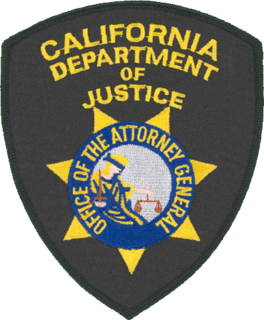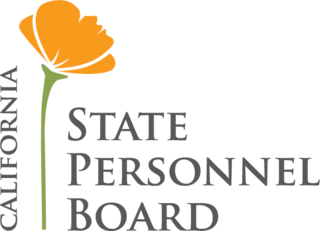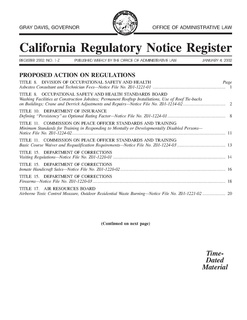
In the law of the United States, the Code of Federal Regulations (CFR) is the codification of the general and permanent regulations promulgated by the executive departments and agencies of the federal government of the United States. The CFR is divided into 50 titles that represent broad areas subject to federal regulation.

The Federal Register is the official journal of the federal government of the United States that contains government agency rules, proposed rules, and public notices. It is published every weekday, except on federal holidays. The final rules promulgated by a federal agency and published in the Federal Register are ultimately reorganized by topic or subject matter and codified in the Code of Federal Regulations (CFR), which is updated annually.
A law enforcement officer (LEO), or peace officer in North American English, is a public-sector employee whose duties primarily involve the enforcement of laws. The phrase can include campaign disclosure specialists, police officers, prosecutors, municipal law enforcement officers, health inspectors, special police officers, customs officers, lawyers, state troopers, federal law enforcement agents, secret agents, special investigators, coast guards, border patrol officers, swat officers, judges, district attorney, bounty hunters, gendarmerie officers, immigration officers, private investigators, court officers, probation officers, parole officers, arson investigators, auxiliary officers, animal control officers, game wardens, park rangers, county sheriffs, constables, marshals, deputies, detention officers, correction officers, sworn campus police officers and public safety officers. Security guards are civilians and therefore not law enforcement officers, unless they have been granted powers to enforce particular laws, such as those accredited under a community safety accreditation scheme such as a security police officer.
The Ralph M. Brown Act is a California law that guarantees the public's right to attend and participate in meetings of local legislative bodies. Located at California Government Code 54950 et seq., it is an act of the California State Legislature, authored by Assemblymember Ralph M. Brown and passed in 1953.

Government procurement or public procurement is the procurement of goods, services and works on behalf of a public authority, such as a government agency. Amounting to 12 percent of global GDP in 2018, government procurement accounts for a substantial part of the global economy.

The law of California consists of several levels, including constitutional, statutory, and regulatory law, as well as case law. The California Codes form the general statutory law, and most state agency regulations are available in the California Code of Regulations.
The California Code of Regulations is the codification of the general and permanent rules and regulations announced in the California Regulatory Notice Register by California state agencies under authority from primary legislation in the California Codes. Such rules and regulations are reviewed, approved, and made available to the public by the Office of Administrative Law (OAL), and are also filed with the Secretary of State.

The California Bureau of Gambling Control is a regulatory agency that is part of the California Department of Justice. It regulates legal gambling activities in California to ensure that gambling is conducted honestly, competitively, and free from criminal and corruptive elements. It is one of two agencies in California regulating gambling, along with the California Gambling Control Commission.

The California Environmental Protection Agency, or CalEPA, is a state cabinet-level agency within the government of California. The mission of CalEPA is to restore, protect and enhance the environment, to ensure public health, environmental quality and economic vitality.

In California, the Employment Development Department (EDD) is a department of government that administers the Unemployment Insurance (UI), Disability Insurance (DI), and Paid Family Leave (PFL) programs. The department also provides employment service programs and collects the state's labor market information and employment data. The department is one of California's three major taxation agencies, alongside California Department of Tax and Fee Administration and the Franchise Tax Board; in addition to collecting unemployment insurance taxes, the department administers the reporting, collection, and enforcement of the state's personal income taxes.

The California Health and Safety Code is the codification of general statutory law covering the subject areas of health and safety in the state of California. It is one of the 29 California Codes and was originally signed into law by the Governor of California on April 7, 1939.

The California State Personnel Board (SPB), one of California's constitutional offices, is one of the California agencies responsible for administration of the merit-based civil service employment system for California state agencies, the other being the California Department of Human Resources.

The California Public Records Act was a law passed by the California State Legislature and signed by then-governor Ronald Reagan in 1968 requiring inspection or disclosure of governmental records to the public upon request, unless exempted by law.
Title 1 of the Code of Federal Regulations, titled General Provisions, is a United States federal government regulation.
A law enforcement agency (LEA) is any government agency responsible for the enforcement of the laws.

The Administrative Procedure Act (APA), Pub.L. 79–404, 60 Stat. 237, enacted June 11, 1946, is the United States federal statute that governs the way in which administrative agencies of the federal government of the United States may propose and establish regulations and grants U.S. federal courts oversight over all agency actions. According to Hickman & Pierce, it is one of the most important pieces of United States administrative law, and serves as a sort of "constitution" for U.S. administrative law.

The California Administrative Procedure Act (APA) is a series of acts of the California Legislature first enacted 15 June 1945 that requires California state agencies to adopt regulations in accordance with its provisions. It predates the federal Administrative Procedure Act that was enacted almost a year later on 11 June 1946.

The California Regulatory Notice Register contains notices of proposed regulatory actions by California state agencies to adopt, amend, or repeal regulations contained in the California Code of Regulations (CCR). It is similar to the role of the Federal Register.
The New Jersey Administrative Code (N.J.A.C.) is the codification of all rules and regulations made by the executive branch agencies of New Jersey.
The California Bureau of Real Estate Appraisers (BREA) is a division of the California Department of Consumer Affairs responsible for real estate appraiser licensing and certification in California.














